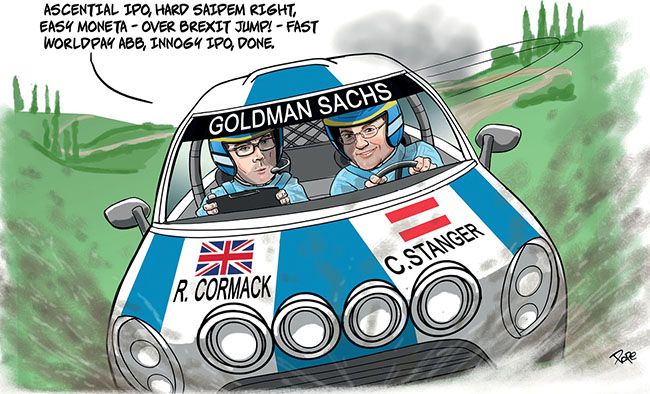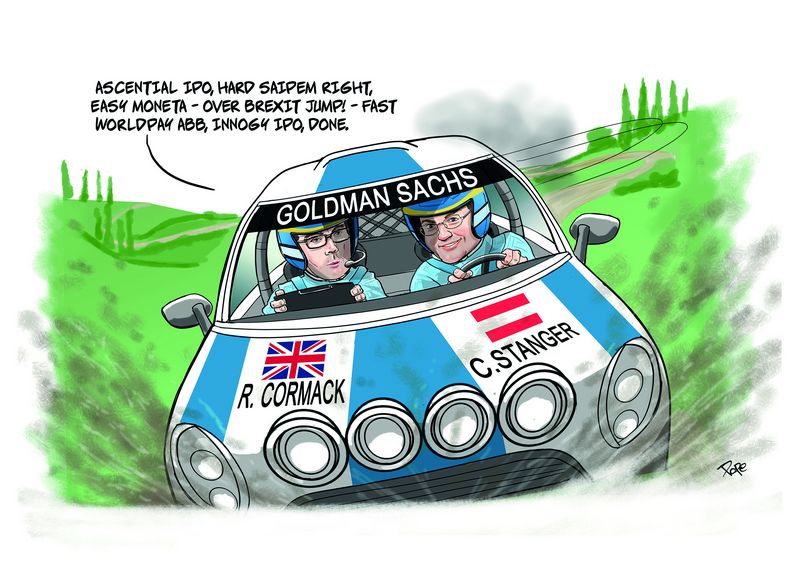Driving deals
Executing the largest IPOs, reopening markets, entering new markets, building on repeat business and picking the right windows in uncertain times – one bank did it all. For always being in the driver’s seat, Goldman Sachs is IFR’s EMEA Equity House of the Year.
“Most of the time when pitching, issuers didn’t even consider us as a bookrunner,” said Christoph Stanger, co-head of EMEA ECM at Goldman Sachs.
A few years ago that would have been a shocking admission, today it is a badge of honour, with responsibility – and fees – now residing at the more senior global coordinator level.
All banks have focused on trying to increase the proportion of top-line positions, while continuing to accept the league table boost of junior bookrunner. None has achieved what Goldman Sachs did in the IFR awards period – a top-line role on every single deal across all cash equity products. The league table may show the US bank slipping from its typical position at the top, but when it comes to being in the driver’s seat, Goldman Sachs is number one.
(Bookrunner roles were taken in structured equity, which has previously been an area of weakness but was much improved this year.)
Volumes were down across all products last year, including a drop of nearly 50% for IPOs, so better-paid senior positions were needed to produce decent revenues.
That put the emphasis on advice, illustrated by Goldman beginning the year with a brace of UK IPOs knowing that the country’s EU referendum – not then scheduled – would disrupt issuance plans later in the year. IPOs for UK spread-betting firm CMC Markets and festival and exhibition group Ascential were not easy.
“We came into a pretty brutal market, impacted by China and falling oil prices, but we didn’t know when there would be an EU referendum and they wanted to get out ahead of that,” said Richard Cormack, co-head of EMEA ECM.
Ascential got done because a handful of accounts were convinced to buy in size – Old Mutual was allocated more than a third of the IPO shares. By late November, the shares were more than 38% above pricing.
It was the first of a number of big judgement calls, with the bank running dual-track processes for Moneta Money Bank, on behalf of GE, and Philips Lighting, as well as Ascential. All three went down the IPO route, with Moneta providing a fat 3% base fee plus 50bp incentive on the float plus further revenues from two accelerated sales that saw GE exit within six months of listing.
That theme of repeat business continued, with the likes of Altice, Kion, NXP, Thule and Worldpay all returning to the US bank for follow-ons.
Moneta was also a benchmark trade in the nascent recovery of emerging markets, with Goldman also leading selldowns in Moscow Exchange, OMV Petrom, Polymetal and Romgaz as well as a fundraising for Alior Bank. Goldman rounded out the awards period with its first lead role on a domestic South African IPO for pharmacy chain Dis-Chem.
Goldman also revived its equity-linked franchise, finishing at its highest level in the league table since 2008, including sizeable dual-tranche deals for Airbus into Dassault Aviation and Wendel into Saint-Gobain.
The year, though, belonged to IPOs.
“An IPO is the ultimate trust relationship; issuers want Goldman Sachs there, that’s where we shoot the lights out,” said Cormack. “On the deals that were differentiated, the deals that matter, such as Moneta Money Bank, Philips Lighting and Innogy, we were at the forefront.”
Notably, Goldman’s roster of tombstones features many mid-cap deals such as Resurs Holding, Maisons du Monde, Tokmanni and Technogym.
At €4.64bn, RWE spin-off Innogy in October was Europe’s largest IPO since Glencore raised US$10bn in 2011. Getting it right mattered, especially following a run of postponements and a disastrous aftermarket for Denmark’s Nets.
Cancellations of the IPOs of Telxius, OfficeFirst and Misys as markets suffered in September and October count against Goldman, but only marginally – no investor loses money on a no-show.
Despite that backdrop, Innogy’s float was upsized with pricing at the top of a narrow range. “We made it a blatant yield story, catching the perfect time in the market when the shift came from defensives to cyclicals,” said Stanger.
Cornerstones are still relatively rare in European IPOs, but a €940m guaranteed allocation from BlackRock for nearly 5% of Innogy helped achieve mid-single digit coverage with pricing at a premium to key peer E.ON.
“The narrow range ensured BlackRock was price-agnostic throughout, so we were not shy to go to the top as we had someone in size ready to do just that,” said Cormack.
“This is not just putting a deal on the conveyor belt,” said Stanger. “This is proper advice, intelligent craftsmanship and thinking about what the market really wants.”
To see the digital version of this review, please click here .
To purchase printed copies or a PDF of this review, please email gloria.balbastro@tr.com


